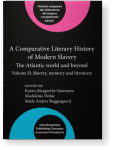Chapter 15
Contradicting histories, memories, fictions
A bricolage of slavery in the early-modern French Caribbean
Now that the debates between history and memory have subsided, their similarities become clearer,
notably that history depends on memory for data and evidence. Often ignored, texts that depict seventeenth century
French-Caribbean slavery are not only historical and memorial (letters and diaries), but fictive in part as well
(Relations, ethnographies and travel narratives). This hybrid corpus is replete with unfilled, perhaps unfillable
gaps; and yet it is marked by two salient contradictions: etiological tensions between the empire’s goals of
conversion vs commerce; and conflicts regarding slaves’ ontological status as thing or human — both contradictions may
function within the corpus’s textual unconscious. Today, Caribbean descendants of enslaved African persons work to
fill (but never close) the traumatic, haunting aporias of history-and-memory through writerly reimaginings. Chamoiseau
inscribes this individual and collective quest with his own uncertainties and contradictions.
Keywords: blackness, conversion, contradictions, enslaved persons, French Caribbean, history, imagination, memory, mercantilism, ontology, slavery
Article outline
- The etiology of enslavement: Commerce versus conversion
- Ontologies of the enslaved: Property or person
- Author queries
-
Notes
-
References
This content is being prepared for publication; it may be subject to changes.
